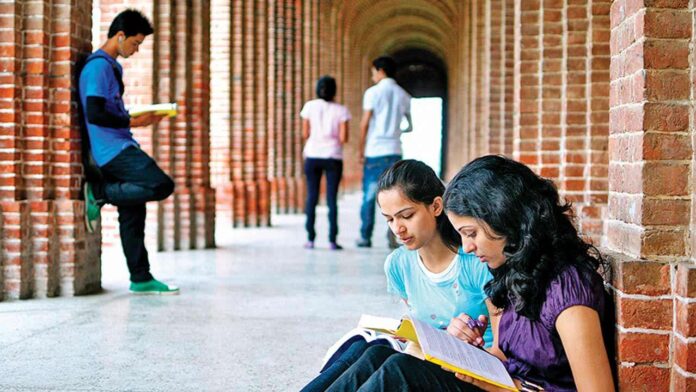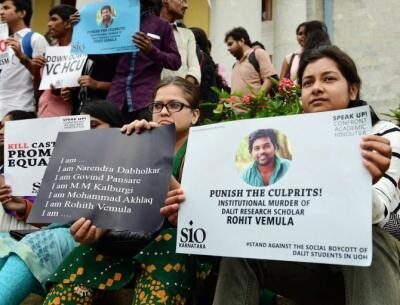
Several accounts of sexual harassment complaints came to light when the current students and the alumni of PSBB School called out one of their teachers in the social media platforms. Rajagopal, Business Studies and Accountancy teacher at PSBB School, K K Nagar, Chennai was the one who was called out. The accounts of sexual harassment include sending porn links to girl students, touching them inappropriately and appearing semi-nude during online classes. The students took it to the social media platform as the Management of the school failed to take action against the perpetrator and thereby enabled an environment in which the perpetrator continued to have access to minor children.
This #Metoo movement also raised the issues of caste discrimination and has led students of other institutions to come out with their own accounts of sexual harassment and caste discrimination that they face in these elite educational institutions. This shows that caste discrimination and sexual harassment in educational institutions are not isolated incidents and it needs to be addressed at the earliest.
First and foremost, we need to understand that these educational spaces are not utopian spaces. These educational institutions too are very much a part of the Brahmanical society that we live in, where caste and patriarchy are enabled. These elite educational institutions whether at the stage of schooling or higher education remain as the spaces where faculty positions as well the student positions are captured mostly by people hailing from upper castes communities. For instance, as per the All India Survey on Higher Education (AISHE) 2018-19, higher education spaces including the ones with a strong social-science orientation where one would expect a greater engagement with these structural issues like JNU, HCU and EFLU are filled with the upper caste faculties to the extent of 80%, 71% and 63% respectively. It is needless to say about the IITs, IIMs and other private educational institutions where the reservation system is not applicable or properly implemented. Further, students hailing from marginalized identities are restricted to access these educational institutions because of their socio-economic conditions. As a result, these upper caste faculties and students as a social group reinforce Brahmanical culture in such institutions and the cultural evolution of such institutions depends on that social group which has captured these spaces.
Secondly, these elite educational institutions enable an environment where students are continuously discriminated against either subtly or confrontationally because of their marginalized social location. The caste identities of the students are not hidden in these institutes. They are known to their peers and teachers through their surnames, through their cultural practices like food habits or even by practices to distinguish themselves like tying caste bands as a marker of caste. Institutional practices like these existed in HCU where caste categories of the students are made public on the admission boards by assigning (star)* to different caste categories. SC category students are assigned one star (*), ST category students are assigned two stars (**) and OBC category students are assigned three stars (***).
Moreover, the space for marginalized identities is always a question in educational institutions, even in their curriculum. The idea of merit in the educational institutions ensures this denial of their space without any regard for the socio-economic background of students from marginalized communities. One common form of discrimination is that students from marginalized communities are told that they are non-meritorious. The below statements stand as an example to it.
“Arre tum log toh Reservation se ho” (Oh you are the ones from reserved categories) and “Tum log toh easily aa jayoge”(you guys can easily get in)
– Experience of Jitendra Suna
JNU Scholar & Student activist, BAPSA
In residential spaces, the discrimination seems to be very acute. Even in spaces like JNU, not only untouchability, there are also instances of ‘unseeability’ in practice, where students from marginalised communities are told, “hum subah tumhara chehra nahi dekhenge” (We will not see your face in the morning). This attitude is coming from a prejudice where if they see the face of Dalits in the morning, they believe their entire day’s work will be ruined. There are also instances in TISS Hyderabad hostel, where a student of marginalized community is always told to take bath later so that the upper caste student who shares the same hostel room with marginalized student can avoid getting ‘dirty’ by taking bath first.
My findings from my research suggest that the discrimination is not only limited to Certificate Hindus like SCs, STs and OBCs but it also extends to minorities, particularly Muslims. According to my respondents in EFLU campus, permissions for Eid gathering had been denied by the administration while Ganesh Chaturthi celebrations were held in the campus spaces. Rather than taking the same approach, festivals of minorities are seen as communal while Hindu majoritarian festivals are not questioned. When I was collecting data in JNU campus, on the Ram Janmabhoomi court verdict day, slogans of ‘Jai Shri Ram’ were raised in order to provoke and threaten students from minority communities in the campus.
Students from minority communities in the campuses are discriminated against just because of their identity. The attack on Najeeb and events aftermath in JNU campus stand as an important example. Even among the students’ and professors’ circles, insensitive comments are made on the way they appear ‘with a beard you are looking like a terrorist’. The political existence of minority students are always questioned where student activists are called terrorists on the campus spaces.

These educational institutions are extremely toxic spaces for students from marginalized identities where comments about their appearance, their language and their sexuality are made without any regard to their mental health. The accounts of sexual harassment including making sexually colored jokes in the classroom spaces, sending porn links to girl students, touching them inappropriately and appearing semi-nude during online classes that students across institutions have called out on the social media platforms remain as proof of such Brahminical patriarchy which has enabled caste and gender discrimination in their educational institutions.
Thirdly, this Brahminical patriarchy ensures that, through these acts of active discrimination and sexual exploitation of marginalized identities, the power and dominance of caste system is ensured in the educational spaces. This power and dominance exercised by the caste oppressors in the educational institutions ensures that students from marginalized castes and marginalized genders are kept out of the system. Students have no other options than to drop out from these educational institutions which are unsafe. The Institutional murders of Rohith Vemula, Fathima Lateef and Payal Tadvi are the outcomes of this Brahminical culture which continuously ensures a toxic environment for the students who are from marginalized identities.

This #Metoo movement raised a very important question of safe spaces in educational institutions. But this idea of safe spaces will remain an illusion unless there are efforts to democratize these educational institutions. Democratizing the institutions ideally means bringing in equity in spaces for the marginalized identities in the truest sense. Starting from the curriculum, faculty positions, and student composition to the SC/ST Cell, Internal Complaints Committee (ICC) and Gender Sensitization Committee Against Sexual Harassment (GS-CASH) in the educational institutions, there needs to be equity in the spaces that we live in. Having said that, this issue of the need for safe spaces needs to be addressed at a societal level by the governments and also by the individuals of this society who remain complicit in perpetuating the Brahmanical patriarchy. At the end of the day, educational institutions are part of the society we live in. It is high time that we dismantle the Brahmanical structure by ensuring equity for different marginalized identities.
(This article is based on Prabakaran’s research work titled ‘Institutional Marginalization, Student Movements and Higher Education in India: An Exploratory Study’ )


